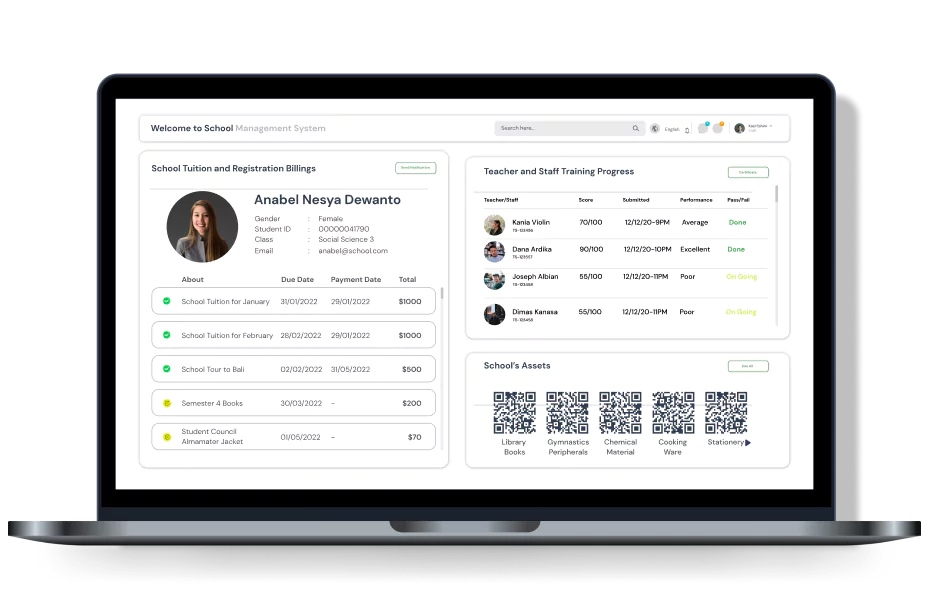Managing school fees in large schools, especially in education-driven countries like Singapore, has always been a challenge in my experience. I’ve seen how manual fee verification can be time-consuming, but a tuition management system offers a smoother solution.
I came across a 2022 study by the Ministry of Education (MOE) that highlighted the heavy administrative burden caused by manual fee tracking. That’s why I find HashMicro’s School Management System so effective.
HashMicro automates fee collection and payment tracking, reduces workload, and ensures accuracy. With the CTC Grant, schools can save up to 70%, making it a more affordable option. I highly recommend trying HashMicro’s free demo to see how it can truly benefit your institution.
Key Takeaways
|

What is Tuition Management Systems?
From my perspective, a Tuition Management System is software that automates the collection and tracking of school fees. It centralizes financial data, reduces manual errors, and eases the burden on school staff. For me, its greatest value lies in ensuring accurate and efficient tuition management.
It works by automating payment plans, sending reminders, and enabling online transactions. Parents and students can access invoices and payment histories through a portal. Administrators can generate reports and monitor transactions in real time. Overall, tuition payment software improves transparency, security, and administrative efficiency.
The Top 7 Benefits of a Tuition Management System
In my view, adopting this system is a strategic move to streamline financial processes in educational institutions, much like implementing a school ERP system. I’ve found that enabling online payments saves parents time, allowing staff to focus on core educational tasks.
Benefits of using tuition payment software include:
- Automated and real-time payment monitoring: Records transactions instantly, removing manual errors. Administrators can view updated payment statuses and spot discrepancies directly from the dashboard.
- High security and data accuracy: Secures financial data with encryption and strict access controls. Schools get precise, error-free payment records for compliance and trust.
- Historical payment records: Maintains a complete history of all payments, ensuring accurate reporting and compliance. Administrators can quickly review past transactions to track overdue fees and plan effective follow-up actions.
- Convenience for parents and students: Offers a user-friendly platform that facilitates easy payment tracking and transaction history management. Parents can make payments through mobile devices at any time, ensuring transparent payment processing.
- Detailed reporting and analytics: Generates customizable reports that give administrators clear insights into financial performance and trends. Schools can analyze payment patterns to forecast future cash flow and improve budgeting decisions.
- Streamlined communication between stakeholders: Utilizes automated alerts and notifications to keep administrators, parents, and students informed about payments. Schools can send reminders about upcoming deadlines directly through the platform, reducing missed payments and misunderstandings.
- Scalability and flexibility: Adapts to the institution’s growth by handling an increasing number of students, payments, and transactions without slowing down. Institutions can easily add new payment plans or extend the system to multiple campuses as their needs expand.
Challenges of Manual Tuition Payment in Large Schools
From my experience, manual fee payments pose significant challenges in large schools, compromising financial efficiency and accuracy. With many students and complex administration, I’ve seen how this system often leads to errors and frustrations for both schools and parents.
Key problems encountered in manual fee payment include:
- Human Error in Transaction Recording: Manual transaction recording in Singapore schools frequently leads to errors, including incorrect entries and missed payments, with manual data entry exhibiting error rates of up to 40%.
- Time-Consuming Administrative Processes: Manual tuition management in large Singapore schools is inefficient, requiring parents to visit in person, leading to long wait times and disrupted routines.
- Difficulties in Payment Tracking: Manually tracking payments in large schools can lead to lost or misplaced records, difficulty identifying late fees, and inaccuracies in financial overviews.
Hashy AI Fact

Need to Know
Managing tuition payments can be time-consuming. Hashy AI automates billing, tracks payments, and sends reminders—making tuition management faster and more efficient.
Request a free demo today!
Features of School Tuition Management Systems

From my perspective, the latest features of tuition payment software not only simplify payment processes but also provide greater convenience for parents. I’ve found that some of the key features making school tuition payments easier include:
- Admission Management: This feature automates invoice generation upon a student’s admission, streamlining the enrollment process and ensuring accurate and timely billing.
- Fee Structure Management: Allows schools to manage and customize fee structures for different levels or classes, ensuring financial transparency and accommodating diverse programs.
- Fee Register: This register maintains a detailed record of all fee transactions, including payments, dates, and statuses, enabling schools to monitor their financial health and prepare accurate reports.
- Student Invoice Portal: It provides real-time billing details and payment histories, enabling parents and students to make online payments and track transactions with ease.
How Does Tuition Management Systems Work?
From my perspective, the administration of an organization can manage financial data from a single central location with the help of online tuition management software. I’ve seen how good software benefits both payors and the institution, not just one side.
Here is how the management of your company and the students or parents who are paying tuition use this software:
1. How tuition management systems work for an administration
- Fast payment processing works by routing tuition payments directly through the system, allowing schools to receive funds within a day.
- Easy tracking of payments is facilitated through a centralized dashboard that records both completed transactions and outstanding bills in real-time.
- Customizable financial reports are generated by selecting filters and report templates within the system, providing administrators with tailored financial insights.
- A reduced manual workload occurs as the system automatically posts payments, updates accounts, and reconciles records, eliminating the need for staff intervention.
- Enhanced payment flexibility is enabled through integration with multiple gateways, supporting credit cards, digital wallets, and bank transfers.
2. How tuition payment softwarework for the payer
- Account creation begins when parents or students register on the system by entering their personal and student details, followed by payment processing.
- Flexible payment plans are established by administrators based on the provided information, and payers select the schedule that best aligns with their needs.
- Convenient features are activated by the system, such as sending reminders, scheduling automatic deductions, and enabling payment tracking.
- Seamless transactions occur as the system processes payments, issues digital receipts, and updates account records instantly, eliminating the need for staff involvement.
- Additional functions operate by integrating payroll modules and collecting financial data to maintain comprehensive school payment records.

Need to Know
Integrating School Tuition Management System with Other School Systems
From my experience, integrating tuition payment software with other school systems fosters more coordinated and efficient management. I’ve found that this integration supports precise decision-making, better resource allocation, and noticeable improvements in education quality.
Such integrations can include:
- School Management System Integration: This integration streamlines various aspects of school administration, from daily reports to attendance and assignment tracking. It enhances communication and efficiency among teachers, students, and parents, contributing to a more cohesive educational environment.
- Accounting System Integration: Integrating with accounting systems ensures a seamless flow of financial information. This facilitates accurate and real-time financial reporting, aids in financial analysis, and provides a comprehensive overview of the school’s financial status.
- Inventory System Integration: Linking the payment application with inventory systems allows for better tracking and managing operational expenses and maintenance costs. This holistic view ensures that financial resources are allocated efficiently and that educational facilities are maintained effectively.
Choosing The Right Software: HashMicro Tuition Management System Software

Conclusion
From my perspective, addressing the complexities of administration in large schools, especially in managing fee payments, makes the adoption of school fee payment applications increasingly essential.
I’ve seen how these applications streamline processes, reduce human error, and improve overall efficiency through advanced financial management features, such as growth monitoring, automatic billing, and fee tracking.
For me, one of the best options is the school management application from HashMicro, which not only simplifies fee payments but also integrates multiple administrative functions. I highly recommend trying the free demo to experience its benefits firsthand.

FAQ about Tuition Management Systems
-
What exactly is a tuition management system?
A tuition system is designed to streamline and manage payment processes within educational institutions. It centralizes financial data, automates payment collection, and enhances transparency in tuition-related transactions.
-
How does a tuition management system benefit educational institutions?
These systems reduce administrative burdens by automating payment collections, decreasing paperwork, and improving financial record-keeping accuracy. They also enhance communication with students and parents regarding payment schedules and outstanding balances.
-
What features should I look for in tuition payment software?
Essential features include multiple payment options (credit cards, direct debit), robust security measures to safeguard financial data, a user-friendly interface for staff and users, and flexibility in payment schedules to accommodate varying financial circumstances.
-
How does tuition management software work for both administrators and payers?
For administrators, the software centralizes financial data, enables easy tracking of payments, and generates customizable financial reports. Payers can create accounts, select payment plans, and access reminders and automatic payment options.
-
Why is it important to switch from manual payment systems to tuition management software?
Manual payment systems often involve inconvenience, time consumption, and errors in tracking payments. Tuition management software streamlines processes improves accuracy, offers payment flexibility, and enhances transparency, benefiting both educational institutions and payers.













